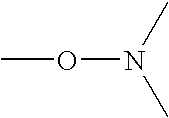Biodiesel cold flow improver
- Summary
- Abstract
- Description
- Claims
- Application Information
AI Technical Summary
Benefits of technology
Problems solved by technology
Method used
Image
Examples
example 1
Poly 2-ethylhexylacrylate Formed by Nitroxyl Mediated CFRP
[0280]
[0281]50 grams of ethylhexylacrylate is added to a 200 ml flask. 0.57 grams of nitoxyl compound O1 is then added. The clear mixture is degassed under vacuum for 1 minute followed by degassing with N2 for 2 minutes (3 cylces). The degassed mixture is heated and stirred at 135° C. The reaction is followed by monitoring the solids content (SC). After 270 minutes the solid content is ˜50% and the molecular weight is determined using GPC with Polymethylmethacrylate standard (PMMA). The Mn is ca. 14500 or n=77.
example 2
Poly(2-ethylhexylacrylate-b-laurylacrylate)
[0282]
[0283]49.98 grams of polymer formed in example 1 is combined with 33.19 g of lauryl acrylate (FLUKA) in a 200 ml. flask to form a homogenous yellowish clear mixture. The clear mixture is degassed under vacuum for 1 minute followed by degassing with N2 for 2 minutes (3 cycles). The degassed mixture is heated and stirred at 135° C. The reaction is followed by monitoring the solids content (SC). After 90 minutes, the reaction temperature is raised to 140° C. and the SC are sampled after 150 minutes. The temperature is then raised to 145° C. and the SC are then sampled every 30 minutes until a target of 80% SC is achieved. GPC using THF and PMMA Standard. Mn=12,980 g / mol; PD=1.35), clear amber liquid.
TABLE 1Additional Polymers and Copolymers Prepared Similarly as in Examples 1 and 2 aboveTheoreticalEXPolymer or Copolymern:m:o:pMn377:20:0:017100477:20:0:016800577:10:0:015700677:10:0:0*16000777:20:0:017400877:10:0:015700977:10:0:0174001077:...
example 16
Poly(n-butylacrylate-b-dimethylaminopropylmethacrylamide)
[0284]2460 g of poly(n-butyl acrylate) (Mn=5800) is prepared in a similar fashion as in example 1, is added to a 5 L reactor followed by 1700 g of dimethylaminopropylmethacrylamide.
[0285]The clear mixture is degassed under vacuum followed by degassing with N2 (3 cycles). The degassed mixture is heated and stirred at 145 C. The reaction is followed by monitoring the solids content (SC). When the solids content reaches 75% the reaction is stopped and the molecular weight is measured by GPC. Mn=7500.
[0286]Transesterification modifications of example 16
[0287]Examples 17-22 are formed from the starting block copolymer of example 16 by transesterifying the butylacrylate monomer units with various alcohols or mixtures of alcohols as described in example 17.
PUM
 Login to View More
Login to View More Abstract
Description
Claims
Application Information
 Login to View More
Login to View More - R&D
- Intellectual Property
- Life Sciences
- Materials
- Tech Scout
- Unparalleled Data Quality
- Higher Quality Content
- 60% Fewer Hallucinations
Browse by: Latest US Patents, China's latest patents, Technical Efficacy Thesaurus, Application Domain, Technology Topic, Popular Technical Reports.
© 2025 PatSnap. All rights reserved.Legal|Privacy policy|Modern Slavery Act Transparency Statement|Sitemap|About US| Contact US: help@patsnap.com



